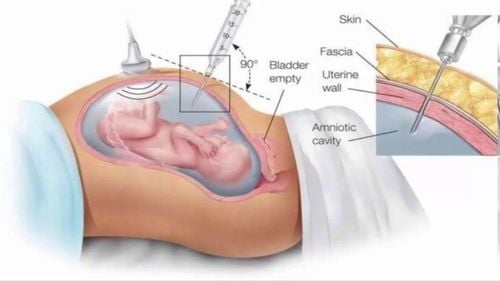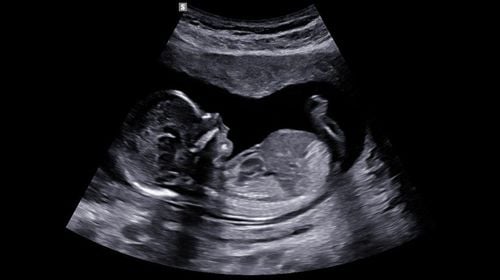This is an automatically translated article.
The article is professionally consulted by Master, Doctor Nguyen Thi Hong On - Department of Obstetrics and Gynecology - Vinmec Phu Quoc International General Hospital.Amniocentesis is a procedure used for prenatal diagnosis after a doctor detects an abnormality in the fetal chromosomes. So how is amniocentesis done and what are the notes that pregnant women need to know before doing amniocentesis test?
1. How is amniocentesis performed?
Amniocentesis is a prenatal test that helps the doctor gather essential health information for the fetus from a sample of the mother's amniotic fluid. The purpose of amniocentesis is to determine if your baby is at risk for certain genetic disorders or chromosomal abnormalities.The procedure to perform amniocentesis is described through the following summarized steps:
First, the pregnant woman lies down with the indicated position and the doctor will perform an ultrasound to determine the position of the fetus and placental status. Through ultrasound images, the doctor determines a safe place for amniocentesis for both mother and baby. The doctor will then clean the mother's abdomen with an antiseptic and then begin injecting a local anesthetic through the skin. Next, the doctor will use a long, thin injector to poke the previously disinfected site, withdrawing about 15-20ml. The amniotic fluid withdrawal takes about 30 seconds. This amniotic fluid sample will then be checked with necessary diagnostic tests. After taking the amniotic fluid, the doctor will check to see if the baby in the womb is healthy or not and if there is nothing affected after amniocentesis.
2. When should a pregnant woman perform amniocentesis?
Because amniocentesis poses few risks to the mother and fetus, it should be performed only in pregnant women at high risk for the genetic abnormality. Specifically, the doctor will prescribe amniocentesis in pregnant women who have the following risk factors:Age over 40 The child's father or mother has a family member with syndromes related to the disorder in blood flow. set of chromosomes The mother herself carries a genetic disease The mother has had an abnormal serological or ultrasound screening test result If the doctor recommends that the pregnant woman undergo an amniocentesis, the procedure This will usually be done between 15 and 18 weeks of pregnancy.

3. Is amniocentesis painful?
Although some amniotic fluid has been removed, the pregnant woman's body will immediately regenerate the amount of amniotic fluid removed and the baby will not be deficient in amniotic fluid after the test. However, whether amniocentesis is painful no longer depends on the condition of each pregnant woman. Some people will feel a little stinging during amniocentesis and some discomfort in the abdomen a few hours later. To overcome that situation, the doctor will prescribe oral medication and tell the pregnant woman to rest on the day of amniocentesis. The next day, abdominal pain usually subsides.Besides, amniocentesis also has certain risks of possible complications, including stillbirth, miscarriage, rupture of membranes, infection. According to recent studies, the risk of miscarriage with amniocentesis is 1/500 (meaning 1 in 500 women who have amniocentesis will have an unintended miscarriage).
There are a number of other methods that can be used as an alternative to or as an adjunct to amniocentesis, including:
Spinal biopsy : A prenatal diagnostic procedure in which a tissue sample of the placenta is removed for testing. instead of amniotic fluid. A biopsy of the placenta is done between the 12th and 14th weeks of pregnancy. Your doctor may also order a special imaging test or blood test. However, these laboratory tests only help the doctor know if there is a problem with your fetus, but do not provide much information for an accurate diagnosis. Before having an amniocentesis, a pregnant woman should understand the potential risks. Consult your doctor to be able to make a more appropriate decision.
Trắc nghiệm: Mẹ bầu nên làm gì khi bị thiếu ối?
Nước ối đóng vai trò quan trọng trong sự tồn tại và phát triển của thai nhi. Trường hợp lượng ối quá ít (thiểu ối) thì sẽ tiềm ẩn những nguy cơ như gây thiểu sản phổi, chèn ép dây rốn,... Trả lời các câu hỏi trắc nghiệm sau sẽ giúp bạn có những cách phòng ngừa và điều trị kịp thời.The following content is prepared under supervision of Thạc sĩ, Bác sĩ y khoa, Tạ Quốc Bản , Sản phụ khoa , Khoa Sản phụ khoa - Bệnh viện Đa khoa Quốc tế Vinmec Phú Quốc
4. What should pregnant women do after amniocentesis?
Pregnant women after amniocentesis may need to stay in the hospital for about 20 minutes for the doctor to monitor before being discharged. Most pregnant women feel that amniocentesis does not cause much pain. Usually, pregnant women need to rest for an hour or more after going home. Within 1 day after amniocentesis, pregnant women should avoid carrying heavy objects, do not have intercourse. The next day, activities can return to normal.
5. How long does amniocentesis have results?
Pregnant women will be advised to go to a medical facility to receive the results. How long it takes to get results depends on the complexity of the test method and the amniotic fluid sample. Usually, amniocentesis results are available within 2 weeks. In some cases, you may have to wait until the third week to get the results. When receiving the results, the doctor will check and guide the pregnant woman about possible bad situations.From there, parents can work with the doctor to plan appropriate care and treatment after the baby is born, or for some diseases, the doctor will conduct treatment for the baby before birth.
In order to minimize the unwanted risks from amniocentesis, Vinmec International Hospital now applies the Non-Invasive Prenatal Screening Method (NIPT). This is the most effective and safe test method available today, performed right from the 10th week of pregnancy through a mother's blood sample. Non-invasive prenatal screening (NIPT) analyzes fetal free DNA in maternal blood to screen for birth defects syndromes that the fetus may have. Only 7 - 10 ml of maternal peripheral blood is needed to test for Down syndrome, Edwards. Patau... and many other fetal syndromes with a high accuracy that surpasses conventional tests.
In addition, this method is also applicable in cases of singleton pregnancy, twin pregnancy, surrogacy...
Please dial HOTLINE for more information or register for an appointment HERE. Download MyVinmec app to make appointments faster and to manage your bookings easily.














